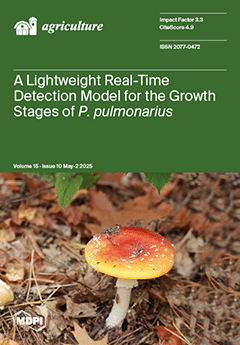One of the key techniques for successful almond tree cultivation in newly irrigated areas is increasing planting density. To investigate this, field experiments were carried out over five consecutive growing seasons (2019–2023) to evaluate the effects of two different tree densities on the vegetative growth and productivity of almond trees (
Prunus dulcis, cv. Tuono) in a semi-arid climate in Southern Italy. The two planting densities tested were 1660 trees per hectare (achieved with 1.5 m intra-row spacing × 4.0 m inter-row spacing) and 833 trees per hectare (3.0 m × 4.0 m spacing).
The results showed that significantly lower values of annual shoot length were recorded in both 2020 and 2021, years characterized by late frosts in March and April. However, with the exception of the first year (2019), when the plants had not yet been influenced by the different planting densities, the annual shoot length was significantly higher in the lowest planting density compared to the highest one in the following years. Additionally, higher annual trunk growth values were recorded at the lower planting density compared to the higher density. By the end of the five seasons, trees at the lower density showed a cumulative trunk growth of 177 mm, whereas those at the higher density reached only 137 mm. No significant effect of the two different tree planting densities on overall fruit development, specifically length, width, and thickness, was observed. As the trees matured, kernel yield per tree increased under both planting densities. However, significantly higher individual tree yields were recorded in the lower-density configuration, reaching 2.70 kg per tree by the end of five seasons, compared to 1.68 kg per tree in the high-density arrangement. In contrast, kernel yield per hectare was greater in the densely planted configuration, achieving 2.81 t ha
−1, whereas the lower-density planting resulted in a yield of 2.25 t ha
−1 by the end of the same period. Furthermore, no significant differences were observed between the two tree planting densities in terms of the percentage of hull per fruit, kernel per nut, or the occurrence of double seeds. Similarly, morphological traits of the nuts and kernels, such as weight, length, width, and thickness, remained unaffected. However, slightly higher kernel weights were noted at the lower planting density.
Full article





